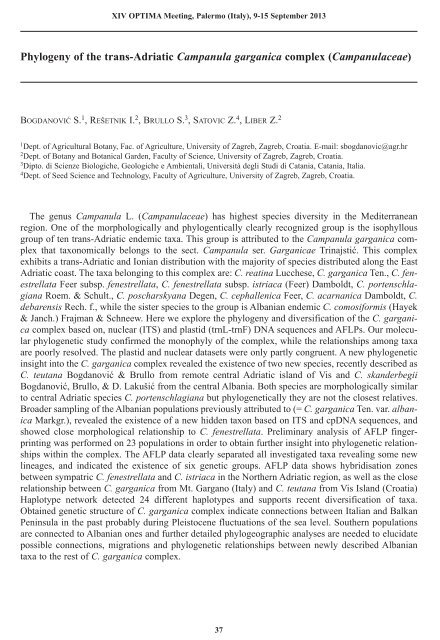Abstracts, XIV OPTIMA Meeting, Palermo (Italy) , 9-15
Abstracts, XIV OPTIMA Meeting, Palermo (Italy) , 9-15
Abstracts, XIV OPTIMA Meeting, Palermo (Italy) , 9-15
You also want an ePaper? Increase the reach of your titles
YUMPU automatically turns print PDFs into web optimized ePapers that Google loves.
<strong>XIV</strong> <strong>OPTIMA</strong> <strong>Meeting</strong>, <strong>Palermo</strong> (<strong>Italy</strong>), 9-<strong>15</strong> September 2013<br />
Phylogeny of the trans-Adriatic Campanula garganica complex (Campanulaceae)<br />
BOGDANOVIĆ S. 1 , REŠETNIK I. 2 , BRULLO S. 3 , SATOVIC Z. 4 , LIBER Z. 2<br />
1 Dept. of Agricultural Botany, Fac. of Agriculture, University of Zagreb, Zagreb, Croatia. E-mail: sbogdanovic@agr.hr<br />
2 Dept. of Botany and Botanical Garden, Faculty of Science, University of Zagreb, Zagreb, Croatia.<br />
3 Dipto. di Scienze Biologiche, Geologiche e Ambientali, Università degli Studi di Catania, Catania, Italia.<br />
4 Dept. of Seed Science and Technology, Faculty of Agriculture, University of Zagreb, Zagreb, Croatia.<br />
The genus Campanula L. (Campanulaceae) has highest species diversity in the Mediterranean<br />
region. One of the morphologically and phylogentically clearly recognized group is the isophyllous<br />
group of ten trans-Adriatic endemic taxa. This group is attributed to the Campanula garganica complex<br />
that taxonomically belongs to the sect. Campanula ser. Garganicae Trinajstić. This complex<br />
exhibits a trans-Adriatic and Ionian distribution with the majority of species distributed along the East<br />
Adriatic coast. The taxa belonging to this complex are: C. reatina Lucchese, C. garganica Ten., C. fenestrellata<br />
Feer subsp. fenestrellata, C. fenestrellata subsp. istriaca (Feer) Damboldt, C. portenschlagiana<br />
Roem. & Schult., C. poscharskyana Degen, C. cephallenica Feer, C. acarnanica Damboldt, C.<br />
debarensis Rech. f., while the sister species to the group is Albanian endemic C. comosiformis (Hayek<br />
& Janch.) Frajman & Schneew. Here we explore the phylogeny and diversification of the C. garganica<br />
complex based on, nuclear (ITS) and plastid (trnL-trnF) DNA sequences and AFLPs. Our molecular<br />
phylogenetic study confirmed the monophyly of the complex, while the relationships among taxa<br />
are poorly resolved. The plastid and nuclear datasets were only partly congruent. A new phylogenetic<br />
insight into the C. garganica complex revealed the existence of two new species, recently described as<br />
C. teutana Bogdanović & Brullo from remote central Adriatic island of Vis and C. skanderbegii<br />
Bogdanović, Brullo, & D. Lakušić from the central Albania. Both species are morphologically similar<br />
to central Adriatic species C. portenschlagiana but phylogenetically they are not the closest relatives.<br />
Broader sampling of the Albanian populations previously attributed to (= C. garganica Ten. var. albanica<br />
Markgr.), revealed the existence of a new hidden taxon based on ITS and cpDNA sequences, and<br />
showed close morphological relationship to C. fenestrellata. Preliminary analysis of AFLP fingerprinting<br />
was performed on 23 populations in order to obtain further insight into phylogenetic relationships<br />
within the complex. The AFLP data clearly separated all investigated taxa revealing some new<br />
lineages, and indicated the existence of six genetic groups. AFLP data shows hybridisation zones<br />
between sympatric C. fenestrellata and C. istriaca in the Northern Adriatic region, as well as the close<br />
relationship between C. garganica from Mt. Gargano (<strong>Italy</strong>) and C. teutana from Vis Island (Croatia)<br />
Haplotype network detected 24 different haplotypes and supports recent diversification of taxa.<br />
Obtained genetic structure of C. garganica complex indicate connections between Italian and Balkan<br />
Peninsula in the past probably during Pleistocene fluctuations of the sea level. Southern populations<br />
are connected to Albanian ones and further detailed phylogeographic analyses are needed to elucidate<br />
possible connections, migrations and phylogenetic relationships between newly described Albanian<br />
taxa to the rest of C. garganica complex.<br />
37






